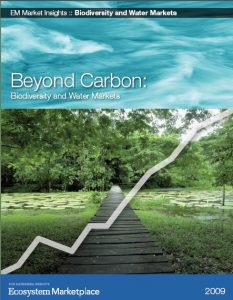Beyond Carbon, Biodiversity and Water Markets
By Ecosystem Marketplace, a Forest Trends initiativeIt is widely acknowledged that well-functioning ecosystems provide reliable and clean flows of water, productive soils, healthy and balanced biota, and many other services for human well-being. It is also widely documented that today many ecosystems and the services they provide are under threat.
The use of markets and market-based mechanisms to conserve and pay for ecosystem services is a growing global trend that is gaining a solid foothold not just in the carbon markets, but also biodiversity and water markets. Furthermore, these payments for ecosystem services (PES) are a practice that is no longer solely important to environmentalists but has become of essential interest to small local communities, government regulators, businesses, and financiers all over the world. PES encompass innovative private deals, financing schemes, and government programs that have been structured around the premise that natural ecosystems provide valuable services, and that if marketed correctly, these services might help watershed and biodiversity conservation pay for itself and generate income for those willing to participate.
This booklet is meant to serve as context and provide background for the Katoomba conference: “Avoiding Deforestation in the Amazon through PES Markets” held in Mato Grosso, Brazil in April 2009. Brazil will have to look beyond carbon markets, to water and biodiversity, to ensure the comprehensive maintenance of all its ecosystem services. To get a stronger sense of how these water and biodiversity financing mechanisms work in practice, the Ecosystem Marketplace has compiled selected articles that introduce the markets, delve into experiences outside of Brazil, and examine developments within the county.
We have broken this volume into four parts: the first summarizes key government initiatives in Brazil, and offers a guide to “the Matrix” of PES schemes around the world (Part 1: The Big Picture). The second offers a close examination of regulated biodiversity and water markets in the United States. (Part 2: The State of Play). The third offers a case study of an innovative biodiversity offset project in Malaysia, PES schemes in the Andes, and an examination of the growing acceptance of ecosystem markets at the federal level in the United States (Part 3: Global Developments). The final part examines established water and biodiversity payment programs in Brazil (Part 4: Local Developments).

